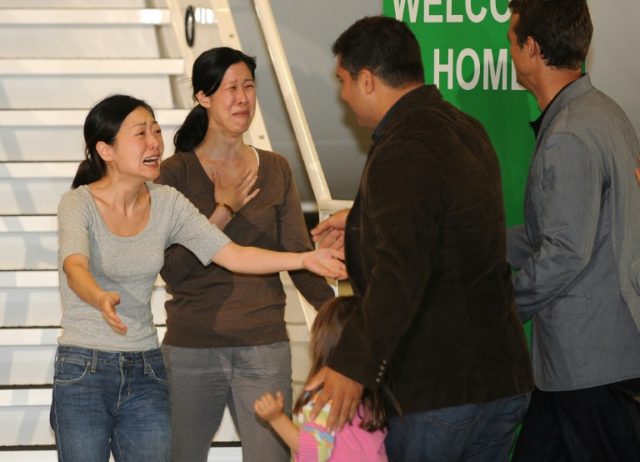Seoul (AFP) – North Korea has a history of detaining Americans and using them as bargaining chips against the United States.
From journalists to missionaries, most Americans detained by the North have been released after high-profile interventions.
President Donald Trump tweeted Wednesday to “stay tuned” for news on the three Americans detained in North Korea, raising hopes for their release before a summit between Trump and North Korean leader Kim Jong Un in the coming weeks.
It is unclear how the three detainees will be released this time, but here are some past examples:
– Former presidents –
Former US president Bill Clinton made a trip to Pyongyang in 2009 to secure the release of journalists Laura Ling and Euna Lee, who were sentenced to 12 years’ hard labour for illegally crossing the border.
And in 2010, Jimmy Carter personally obtained the release of Aijalon Mahli Gomes, who had been handed eight years’ hard labour for illegal entry.
Clinton met with then-leader Kim Jong Il, while Carter also held talks with top officials — and in both cases Pyongyang came away with major propaganda opportunities but little to show for the process in diplomatic terms.
The North’s official KCNA news agency reported that Clinton had an “exhaustive conversation” over dinner with Kim and passed on a verbal message from then-president Barack Obama.
US officials said Clinton — who travelled in an unmarked jet — went to North Korea as a private citizen with the authority to negotiate only for the release of the Americans.
– Spy chief –
US citizens Kenneth Bae and Matthew Miller were released after a secret mission to North Korea by James Clapper, then the Director of National Intelligence.
Clapper spent less than a day in Pyongyang, conducting talks with senior officials, but did not meet Kim Jong Un before flying out with the two freed men.
Clapper told CBS that he carried a short letter from Obama identifying him as the presidential envoy but made it clear that his mission was recovering the two US citizens.
He noted that the North Koreans were disappointed that he did not come bearing a “breakthrough” from the US government, but did not detail what offers the hosts were hoping for.
– Congressman –
In 1996, US Congressman Bill Richardson brought home American Evan Hunziker, who had swum naked and drunk across the Yalu River from China to North Korea, where he was arrested and charged with spying.
Richardson went to North Korea as a private citizen, but was accompanied by US officials.
The North Koreans initially demanded $100,000 for Hunziker’s illegal entry into the country but later agreed to free him after his $5,000 hotel bill was paid.
Less than a month after his return, however, Hunziker committed suicide.
– Diplomat –
The release of American student Otto Warmbier last year was secured after Joseph Yun, the State Department’s then-special representative for North Korea policy, made a secret trip to Pyongyang.
It came after a flurry of covert diplomatic contacts between Washington and Pyongyang amid an escalating war of words between North Korean leader Kim Jong Un and President Donald Trump.
But after nearly 18 months in captivity, the 22-year-old arrived home in a state of coma and died a week later.
US officials were infuriated by Warmbier’s death and Trump has accused North Korea of brutally abusing the American student.
Rather than providing a diplomatic opening, Warmbier’s release prompted Washington to issue a travel ban to the isolated country and put Pyongyang back on its list of state sponsors of terrorism.

COMMENTS
Please let us know if you're having issues with commenting.